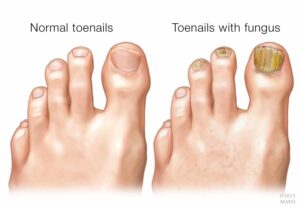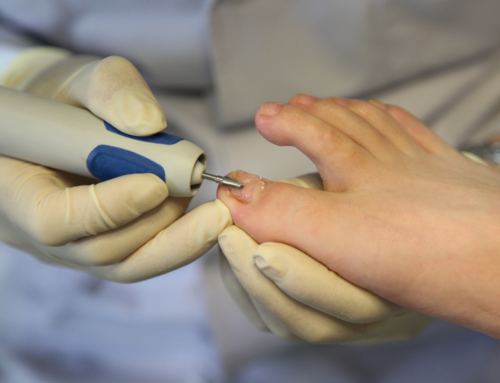Using bleach to treat toenail fungus can be unsafe. It is important to be very careful when choosing a home remedy to treat a toenail fungus infection. It is always recommended to go see a specialist who will consult you on the best treatment option for you.
What Is Nail Fungus?
Nail fungus, or onychomycosis, is an infection caused by microscopic fungi that invade the nail and the skin beneath it. It usually starts as a small discolored spot and spreads slowly over time.
You may notice:
- Yellow, white, or brown discoloration
- Thickened, brittle, or crumbling nails
- Nails lifting away from the nail bed
- Odor or discomfort when wearing shoes
Because the fungus often lives under the nail plate, it can be hard for many home remedies, including bleach treatment for nail fungus, to reach the real source of the problem.

Using bleach for toenail fungus infections
A toenail fungus infection can sometimes be perceived as “dirt”. It makes sense that some people would think bleach would be a good option to “clean” it. Sometimes, even online blogs and articles may recommend this dangerous treatment. Usually, these are not written by people with any medical training. It is important to understand the risks of any treatment you attempt. Especially if it is done at home and involves chemicals like bleach. Using bleach on your toes and skin will like a bad idea once you understand the harm it can do. As well as the lack of benefits that the chemical has for toenail fungus.
Bleaching is not effective as a topical treatment for fungus for different reasons. The most important is that cleaning products like bleach are actually designed to be as harsh as possible. This is necessary when using them for cleaning. However, the skin of humans is not designed as such and is more susceptible to the dangers of bleach. Any type of contact with bleach risks bad damage to the skin. It is not worth the attempt. Symptoms from using bleach on the skin include irritation, redness, and pain. Also, chemical burns which can cause blistering and even permanent damage to the skin.
Harmful side effects to consider
For example, when deeper layers of skin become burned and damaged from bleach, causes the skin’s natural protection from infection is to diminish. This is an important barrier from infection for the entire body, and deep chemical burns could have implications for the body itself.
Unsafe bleach usage includes the necessity for medical treatment for chemical burns. Treating may involve IV fluids, antibiotics, physical therapy, and cosmetic surgery; to avoid chemical burns developing in the first place, don’t use bleach on your skin at all. Toenail fungus is often an embarrassing and frustrating condition to treat, but bleach shouldn’t even be a last resort.
There are much more effective treatments available for toenail fungus out there that are overall much better options than bleach. Bleach usage has only one benefit, which is convenience. However, the inconvenience of a severe chemical burn is much scarier and more annoying to deal with than simply receiving effective treatment from a licensed podiatrist in the first place.

softening fungal toenails is key
Treatment options for toenail fungus
If you do find yourself with a toenail fungus infection, there are several treatment options recommended by foot doctors. Here are some of the common approaches:
- Topical treatments: Over-the-counter creams can help prevent toenail fungal infections. However, they are not very effective for treating an active infection and have a success rate of less than 10%. These creams are most useful as preventive measures or for mild cases of toenail fungus.
- Oral antifungal medication: Medications are commonly prescribed for more severe cases of toenail fungus. However, they come with potential side effects, including liver toxicity. Routine blood testing to monitor your liver are necessary during the course of treatment, and the average cure rate is only around 60%.
- Laser treatment: The most advanced option for toenail fungus treatment is laser therapy. Laser treatment offers a non-invasive and effective approach to eliminating toenail fungus. Various lasers are available, with differing success rates and FDA approvals. The PinPointe laser treatment, approved by the FDA, is a highly effective option, typically requiring only one session and offering no downtime or pain. It targets the fungus directly, penetrating the nail and killing the infection at its source.
For toenail fungus treatment, we highly recommend the PinPointe Laser as it boasts the highest cure rate in the market. It has no side effects, can go about your daily activities right after, and is a painless procedure.
We offer free consultations at Laser Nail Therapy
We offer free consultations to see if laser treatment is right for you. At our clinic, laser nail therapy with the PinPointe Footlaser is our specialty. We focus on this treatment because it offers a safe, effective, and medication-free solution for stubborn toenail fungus. We understand how frustrating it can be to deal with thick, discolored nails and how overwhelming it is to sort through different treatment options.
During this consultation, our foot doctors will evaluate your nails, discuss your health history, and determine whether laser treatment is the best choice. During your consultation, we will:
- Examine your nails to confirm the diagnosis and assess severity.
- Explain exactly how the PinPointe FootLaser works and what you can expect during and after treatment.
- Give you a realistic timeline for seeing clearer, healthier nails.
- Answer any questions you have about nail care and preventing reinfection.
Our goal is to help you confidently move forward with a treatment plan that finally addresses your toenail fungus safely and effectively, without the side effects or drug interactions of oral medications.





